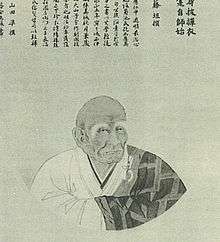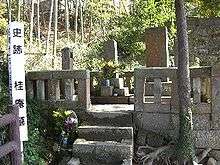Keian Genju
- For the Japanese era, see Keian (1648-1652).

Keian Genju at Kagoshima

Tomb of Keian Genju in Kagoshima
Keian Genju (桂庵 玄樹, 1427 – June 28, 1508) was a Japanese Buddhist monk [1][2] who studied classics under Ishō at Nanzen-ji.[3]
Keian accompanied the 1466 mission to the Ming court in China. In Beijing, he was favored by the Chenghua Emperor.[4] Keian delayed his return to Japan until 1475.[4]
Keian was the first to translate Zhu Xi's Collective Commentaries on the Great Learning into Japanese.[5]
Keian founded Satsunan-gakuha, a neo-confucianist school in Kagoshima.[6]
See also
Notes
- ↑ Ponsonby-Fane, Richard. (1962). Sovereign and Subject, p. 242-246.
- ↑ Iwao, Seiichi et al. (2002). Dictionnaire historique du Japon (Vol. I), p. 1490.
- ↑ Ponsonby-Fane, p. 243.
- 1 2 Ponsonby-Fane, p. 244.
- ↑ Xinzhong Yao. (2005). An Introduction to Confucianism, p. 127.
- ↑ Iwao, Seiichi et al. (2002). Dictionnaire historique du Japon (Vol. II), p. 2376.
References
- Iwao, Seiichi, Teizō Iyanaga, Susumu Ishii, Shōichirō Yoshida et al. (2002). Dictionnaire historique du Japon (Vol. I), (Vol. II). Paris: Maisonneuve & Larose. ISBN 978-2-7068-1632-1; OCLC 51096469
- Ponsonby-Fane, Richard Arthur Brabazon. (1962). Sovereign and Subject. Kyoto: Ponsonby Memorial Society. OCLC 1014075
- Xinzhong Yao. (2005). An Introduction to Confucianism. Cambridge: Cambridge University Press. ISBN 978-0-521-64312-2; ISBN 978-0-521-64430-3; OCLC 255153845
This article is issued from Wikipedia - version of the 10/3/2016. The text is available under the Creative Commons Attribution/Share Alike but additional terms may apply for the media files.